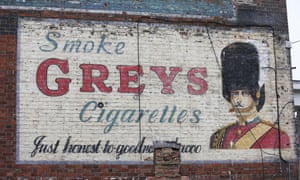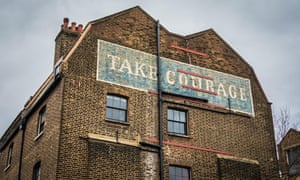During a recent lockdown refurbishment of my local pub in Glasgow, it wasn’t the aesthetic changes to the Titwood Bar’s exterior that piqued people’s curiosity. Most eyes were drawn instead to the detail of a faded sign that began to appear on the wall above, eventually displaying “The Elbow Room” in handsome, intricate lettering.
Shared stories on social media from enthusiastic locals followed, revealing that this was one of Glasgow’s most sophisticated drinking dens in the 1950s: a cocktail lounge where dapper barmen in white suits and black bow ties served Celtic and Rangers players. Despite living only a 10-minute walk from this pub in Strathbungo, in the south of the city, and spending many hours socialising in it, I had no knowledge of its vibrant past. It took a ghost sign, and those who remembered it before it was a ghost, to bring it to life.
While many of us are spending lockdown focusing on brighter days ahead, I’ve found joy in exploring the past. Having spent most of the past year restricted to my home city, I’ve tried to bring purpose to my daily walks by finding fresh discoveries in streets I know well. And in searching for new depths, I’ve found a new hobby: spotting ghost signs.

“Before the pandemic we were all rushing around to meetings or to catch the last tube and didn’t have any reason or time to slow down and look at our surroundings,” says Helen Cox, author of Fading London: The City’s Vanishing Ghost Signs. “The pandemic has forced people to slow down. When you become aware of what is around you, the history just waiting for you to notice it, your perspective changes. For all the real horror we’ve had in the past year, there’s something beautiful about that.”
Ghost signs are hand-painted advertisements – usually dating from 1900 to 1930 – that remind us of a city’s past life. It is estimated that less than 1% of the original signs now remain.
I’m not the only one fascinated with them: the three most popular Facebook groups dedicated to their documentation have more than 20,000 members, and the hashtag #ghostsign has been used more than 90,000 times on Instagram.
“Ghost signs can be approached from the perspectives of artistic design, advertising and commercial history, and local history,” says Sam Roberts, who runs ghostsigns.co.uk and the Instagram feed @mrghostsigns. “Architects are interested in them, as are typography enthusiasts. It’s a topic a lot of interest groups can gather around and get value from.”

Ghosts signs can be found in most UK towns and cities. Glasgow has dozens, many of them documented on ghost-sign walking tours (currently self-guided), which can be downloaded from Ghost Signs of Glasgow. London has hundreds, but Cox names Camden as the neighbourhood with the highest concentration, including a Boots The Chemist ghost sign opposite Camden tube station. East London is also rich with them: a Black Cat Cigarettes one on Dingley Road, Islington, comes with the cost of the cigarettes (10 for 6d), and a beautiful faded advert for Bloom’s Pianos on Kingsland Road.
The oldest known ghost sign in the UK is thought to be on George Street in Bath, and dates from approximately 1820, according to Kirsten Elliott co-author of Ghost Signs of Bath. It was discovered when plastering fell off the side of The Porter pub to reveal faded lettering appearing to advertise the building’s former life as a chemist. Frequently photographed ghost signs include adverts for Bovril and Greys Cigarettes: notable for their size and position, they’re painted one above the other on the end of a redbrick block of flats in Bedford.
An ad for Bile Beans just outside the city walls in York is famous not only for its striking yellow colour but the dilemma it presents in how best to preserve ghost signs: this example was recently touched up with fresh paint, but critics say this destroyed the sign’s authenticity. The “Take Courage” ghost sign opposite London Bridge station is a particularly pertinent message for passersby at this time.

My ghost-sign spotting journey has taught me the importance of acting fast. I took a trip to the Glasgow neighbourhood of Govanhill only a few days after a photograph of a ghost sign was posted on social media – to find it had already been painted over. Not everyone shares the nostalgia: the signs are often fleeting, briefly visible before being consigned to history once more, perhaps to be revealed to future generations.
Roberts hopes that through his website, London ghost-sign app and social media accounts (which have more than 25,000 followers), he will be able to raise awareness of ghost signs, making them revered, and protected.
“Sign writing is a craft,” he says. “Those who did it went through a long period of training. I hope the more people become aware of ghost signs, the more they will realise their significance, and those who have a ghost sign on their building will learn to protect them.”
• Tell us about your favourite ghost sign in the comments below





